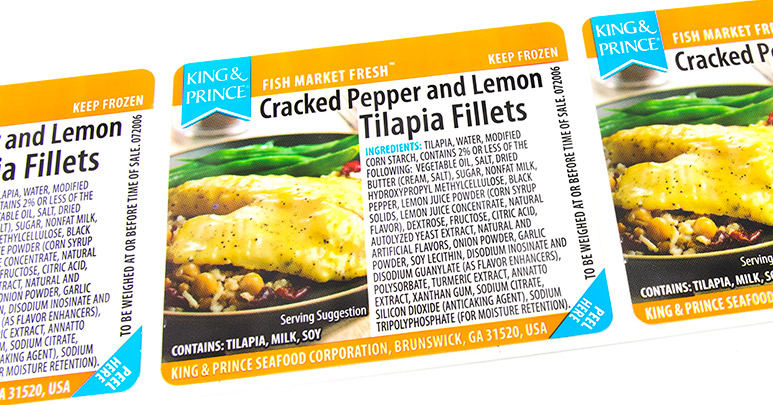
Did you know that food label materials have different reactions to freezing temperatures, which can affect both their looks and performance? Using label materials that aren’t designed for cold conditions can cause you major headaches down the road, as well as, wasted time and resources. That’s where freezer-grade labels can save the day. In this article, we’ll explain what you need to know about these specialty labels and how to find a material that is optimal for your labeling needs.
What Can Freezer-Grade Labels Be Used For?
Freezer-grade labels are used for a variety of purposes like identification, warning tags, directions, and more. Below are some of the most popular uses for custom freezer labels:
- Pre-frozen food packaging
- Cold storage and distribution
- Contract packaging (aka “co-packing”) of products
- Blast freezing/industrial kitchen
- Outdoor elements/sub-zero
- Cryogenic laboratories
- Corrective labeling for cold environments
Depending on what you’re labeling and the environment your food labels will be exposed to, there are certain materials that will better be suited for the job than others. With so many variables, it’s essential to have all the details of your labeling project prepared before ordering custom labels to reduce miscommunication and delayed order times. Let’s see what factors influence material choices so you can get a better idea of how to move forward with your freezer-grade labels.
It’s All In the Label Materials
The success of your labels largely depends on the materials that are used. That’s why knowing the conditions and environments your labels will be exposed is crucial when selecting materials that will work best for your product or whatever item you’re labeling. Below are questions you should have the answer to before buying freezer-grade labels.
- What are you labeling?
There are a variety of things that can require freezer-grade labels: food products, equipment, machinery, shipping boxes, etc. Depending on the surface that you’re labeling, it can have different reactions to label materials. For example, a paper material that works on cardboard may not work as well on metal or glass. Let our customer service reps know what type of surface you’re applying the labels to, so they can help you select compatible label materials.
- What is the application surface like?
Pressure sensitive labels adhere best to clean, smooth, dry, non-porous surfaces, but if you’re labeling something that isn’t like that, let us know so we can use the right label adhesive. Another consideration is the shape of the item you’re labeling. Applying a label to a flat surface is easier than something with curves which can cause labels to crease or lift up. A thin, flexible material with a ‘high initial tack’ adhesive (i.e. sticks quickly on the first contact) is a popular solution for labeling curved surfaces.
- Do you need blank or pre-printed labels?
Blank labels are often used in warehouse and manufacturing facilities to print inventory, shipping, or barcode labels on the fly. If you need blank freezer-grade labels, direct thermal and thermal transfer paper are excellent options. Paper label materials, however, have a shorter lifespan than film labels, so if you need more durable labels, pre-printed is the way to go since there are more material options to choose from.
- Will the label be outdoors, indoors, or both?
One has fluctuating temperatures and weather patterns, the other is a controlled environment with little fluctuation. If your labels will be used outdoors, it’s important that the label material can stand up to sunlight, wind, rain, dirt, and other elements your labels can encounter. Indoor applications, however, can get away with using less expensive label materials since the labels don’t have to be as durable. If your labels will face both indoor and outdoor conditions, it’s best to design your labels for outdoor conditions to ensure they can work in both environments.
- What temperature(s) will the label face?
There are two factors that must be considered when it comes to temperature capabilities for freezer-grade labels: minimum application and service range. Label materials, specifically adhesives, have what’s called a ‘minimum application temperature’ which refers to the lowest temperature that you can apply the label and expect it to stick. ‘Service temperature range’ is the temperature range the label material will adhere to the product or item. It’s crucial to know what temperatures your label will be exposed to before, during, and after label application so you don’t end up with a label material that doesn’t stick due to temperature incompatibility.
- How long do you need the label to last?
Label materials have different characteristics and levels of strengths to suit various labeling needs. For example, labels that need to last for several years will be different than labels with a shorter lifespan. Films like vinyl and polyester would be too strong and expensive for temporary labels, and thermal transfer paper would be too weak to handle outdoor conditions. Knowing what you need out of your labels will help us figure out which combination of label materials will work best for your operations.
This is a lot of information, but if you walk away only remembering one thing, it should be this: the more you know about the item you’re labeling and the conditions it will face, the easier it will be to get freezer-grade labels that meet your needs. Our customer service team would be happy to help you get started on your labeling project, just give us a call at 1-800-475-22365 or email sales@consolidatedlabel.com!


